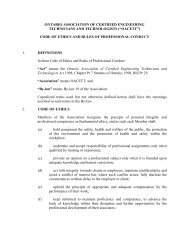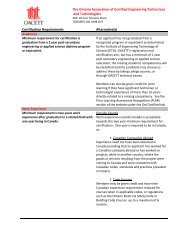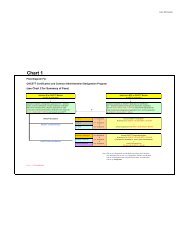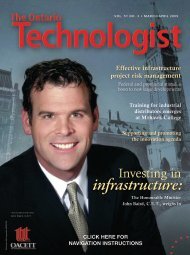MINISTRY DRAFT OACETT SURVEY REPORT
MINISTRY DRAFT OACETT SURVEY REPORT
MINISTRY DRAFT OACETT SURVEY REPORT
You also want an ePaper? Increase the reach of your titles
YUMPU automatically turns print PDFs into web optimized ePapers that Google loves.
PROSPERITY DEMONSTRATION PROJECT<br />
TRAINING NEEDS ASSESSMENT<br />
FOR THE<br />
AUTOMOTIVE PARTS MANUFACTURING SECTOR<br />
5 <strong>SURVEY</strong> OF TECHNICAL EMPLOYEES<br />
by<br />
Colleges of Ontario Network for Education and Training (CON*NECT)<br />
—A Division of the Association of Colleges of Applied Arts and Technology of Ontario (ACAATO)—<br />
August 2001
TABLE OF CONTENTS<br />
Page<br />
1 INTRODUCTION<br />
1.1 PARTNER CONTRIBUTIONS ………………………………………… 1<br />
1.2 METHODOLOGY …………………………………………………… 1<br />
1.3 <strong>SURVEY</strong> SAMPLE …………………………………………………… 3<br />
1.4 <strong>SURVEY</strong> PROCESS AND TIME FRAME ………………………………… 3<br />
1.5 RESPONSE RATE …………………………………………………… 4<br />
2 <strong>SURVEY</strong> FINDINGS<br />
2.1 PROFILE OF RESPONDENTS …………………………………………… 5<br />
2.1.1 Geographic Distribution …………………………………………... 5<br />
2.1.2 Professional Certification …………………………………………… 6<br />
2.1.3 Technology Discipline …………………………………………… 6<br />
2.2 CURRENT EMPLOYMENT PATTERNS ………………………………… 7<br />
2.2.1 Employment Status …………………………………………… 7<br />
2.2.2 Job Stability …………………………………………………… 8<br />
2.2.3 Expected Job Mobility ………………………………………… 9<br />
2.2.3.1 Reasons for Looking for a Different Position …… 10<br />
2.2.3.2 Industry Where Employment Will Be Sought …… 17<br />
2.3 CURRENT TRAINING PATTERNS ………………………………… 18<br />
2.3.1 Responsibility For Training ………………………………… 18<br />
2.3.2 Employer Support for Training ………………………………… 19<br />
2.4 INDUSTRY TRENDS .………………………………….…………………. 20<br />
2.4.1 Broad Industry Trends Precipitating Training Needs ……………… 20<br />
2.4.2 Positions on Environmental Technologies ………………………... 21<br />
2.5 FUTURE TRAINING PRIORITIES …………………………………… 22<br />
2.5.1 Specific Skill/Knowledge Areas …………………………………… 22<br />
2.5.1.1 Technical Skills …………………………………………… 24<br />
2.5.1.2 Information and Technology Skills ………………………… 25<br />
2.5.1.3 Management/Supervisory Skills ………………………… 26<br />
2.5.1.4 Personal Development Skills ………………………… 27<br />
2.5.1.5 Technical Program Management Skills ………………. 28<br />
2.5.1.6 Sustainable Environmental Technology Skills……………… 29<br />
2.6 TRAINING DELIVERY ……………………………………………………… 30<br />
2.6.1 Interest in Learning Technologies …………………………………… 30<br />
2.6.2 Additional Skills Needed to Use Learning Technologies ……… 31<br />
2.6.3 Preferred Training Times …………………………………… 32<br />
APPENDIX 5 - A<br />
EMPLOYEE QUESTIONNAIRE<br />
ii
LIST OF TABLES<br />
Page<br />
2.1 PROFILE OF RESPONDENTS<br />
TABLE 2.1.1 Geographic Distribution of Respondents …………………… 5<br />
TABLE 2.1.2 Professional Certification of Respondents …………………… 6<br />
TABLE 2.1.3 Technology Discipline of Respondents ……………………………… 7<br />
2.2 CURRENT EMPLOYMENT PAT TERNS<br />
TABLE 2.2.1 Employment Status of Respondents ……………………………… 8<br />
TABLE 2.2.2 Job Stability of Respondents ………………………………………… 8<br />
TABLE 2.2.3 Expected Job Mobility Next 24 Months……………………………… 9<br />
TABLE 2.2.3.1 Reasons for Looking for a Different Position …………………… 10<br />
2.3 CURRENT TRAINING PATTERNS<br />
TABLE 2.3.1 Primary Responsibility For Initiating/Delivering Training ………... 19<br />
TABLE 2.3.2 Employer Supports for Training ……………………………… 19<br />
2.4 INDUSTRY TRENDS<br />
TABLE 2.4.1 Industry Trends Precipitating Training Needs …………………… 21<br />
TABLE 2.4.2 Positions on Environmental Technologies …………………… 21<br />
2.5 FUTURE TRAINING PRIORITIES<br />
TABLE 2.5.1 Skill/Knowledge Areas Rated High Priority for Training ………… 22<br />
TABLE 2.5.1.1 Technical Skills: Regional Breakdown ……………………………… 24<br />
TABLE 2.5.1.1.1 Technical Skills: Respondents Forecasting Training Next 36 Mos. …. 24<br />
TABLE 2.5.1.2 ICT Skills Training: Regional Breakdown …………………… 25<br />
TABLE 2.5.1.2.1 ICT Skills: Respondents Forecasting Training Next 36 Mos. ……… 25<br />
TABLE 2.5.1.3 Management/Supervisory Skills Training: Regional Breakdown 26<br />
TABLE 2.5.1.3.1 Management/Supervisory Sk ills: Respondents Forecasting Training Next 36 Mos. 26<br />
TABLE 2.5.1.4 Personal Development Skills Training: Regional Breakdown 27<br />
TABLE 2.5.1.4.1 Personal Development Skills: Respondents Forecasting Training Next 36 Mos. 27<br />
TABLE 2.5.1.5 Technical Program Management Skills Training Regional Breakdown 28<br />
TABLE 2.5.1.5.1 Tech. Program Management Skills: Respondents Forecasting Training Next 36 Mos. 28<br />
TABLE 2.5.1.6 Sustainable Environmental Technologies Skills Training: Regional Breakdown 29<br />
TABLE 2.5.1.6.1 Sust. Environ. Technologies Skills: Respondents Forecasting Training Next 36 Mos. 29<br />
2.6 TRAINING DELIVERY<br />
TABLE 2.6.1 Interest in Specific Learning Technologies ……………………… 30<br />
TABLE 2.6.2 Additional Skills Needed to Use Learning Technologies …………… 31<br />
TABLE 2.6.3 Preferred Training Times …………………………………………… 32<br />
iii
1 INTRODUCTION<br />
CON*NECT collaborated with the Ontario Association of Certified Engineering Technicians and<br />
Technologists (<strong>OACETT</strong>) to design and carry out a training needs survey of technicians and<br />
technologists, including those currently employed in the automotive parts manufacturing sector.<br />
1.1 PARTNER CONTRIBUTIONS<br />
<strong>OACETT</strong> made the following key contributions to the project:<br />
• provided strategic advice regarding association membership<br />
• reviewed the project design with the association's Member Services Advisory Board<br />
• reviewed the questionnaire<br />
• arranged for pilot of the questionnaire with technicians and technologists across the province<br />
• promoted the study through presentations and written articles over several months to raise<br />
interest in participation<br />
• provided supervisory, web administration, and other staff to link the survey questionnaire<br />
server with the <strong>OACETT</strong> web site, to review and test the electronic version of the<br />
questionnaire, and to distribute the questionnaire by email to the sample of 8,096 members<br />
selected<br />
• reviewed the draft needs analysis report<br />
• planned follow-up action<br />
• assisted with dissemination of results<br />
1.2 METHODOLOGY<br />
An on-line questionnaire designed for self-completion and electronic return was developed.<br />
Electronic technology was selected as the distribution method for the survey for several reasons:<br />
• The sample represented by those on the <strong>OACETT</strong> email distribution list was approximately<br />
40% of the total membership and represented a large sample size.<br />
• Individuals listed had Internet access.<br />
• Individuals listed were accustomed to communications via the Internet.<br />
• The electronic method was a cost and time effective method of reaching a large sample size.<br />
1
• The capacity to electronically download responses into a database eliminated the need for<br />
manual data entry, saving time, cost, and eliminating potentia l human error.<br />
The content of the survey questionnaire focused on current skill levels; training practices;<br />
employee mobility; and training needs and priorities. In parallel with the survey of employers in<br />
the automotive parts manufacturing sector, specific questions addressed the impact of emerging<br />
new safety and environmental regulations, expanding information technologies, and the need for<br />
new skills combinations.<br />
Questionnaire pilot<br />
The relevance and validity of the questions developed for the survey of technicians and<br />
technologists were reviewed through a pilot process. The draft questionnaire was sent by<br />
<strong>OACETT</strong> to seven members of its Member Services Advisory Board by email. These individuals<br />
were asked to complete and return the questionnaire as well as recording their comments about<br />
specific questions and their suggestions to simplify completion of the questionnaire. The seven<br />
participating individuals provided feedback through written comments received by fax and email,<br />
and/or review of their input via telephone. Subsequent to the feedback received, minor<br />
adjustments in the questionnaire draft were made. A copy of the questionnaire may be found in<br />
Appendix A.<br />
Conversion to electronic format<br />
Once the survey content was finalized, the questionnaire was re-designed and programmed for<br />
distribution and response submission via the Internet (by the Georgian Research Institute at<br />
Georgian College.) The html form and scripts remained on the Georgian NT server. This format<br />
enabled Georgian to monitor response rates on a daily basis, respond to and assist individual<br />
respondents who might experience technical difficulties, and to continuously download responses<br />
into a database.<br />
The electronic format provided direct links to the questionnaire from the emailed message to<br />
members on the <strong>OACETT</strong> distribution list, and also from the members-only section of the<br />
<strong>OACETT</strong> website. This latter link provided survey access for those who wanted to participate but<br />
who were not on the sample distribution list.<br />
2
Prior to distribution of the questionnaire to the selected sample, a pretest of the electronic format<br />
was conducted by Georgian, <strong>OACETT</strong>, and CON*NECT. This resulted in minor adjustments to<br />
the program and design.<br />
An email message promoting the survey, and providing a click-able link to the questionnaire, was<br />
sent to 8,096 <strong>OACETT</strong> members (those with current email addresses in the <strong>OACETT</strong> member<br />
data base). In an effort to maximize the response rate, <strong>OACETT</strong> members were also alerted to the<br />
availability of the questionnaire via the <strong>OACETT</strong> website, through articles describing the project<br />
in the Inf<strong>OACETT</strong> newsletter and in the Ontario Technologist, as well as at presentations at<br />
regional meetings across the province.<br />
1.3 <strong>SURVEY</strong> SAMPLE<br />
Individual contacts for the survey were provided by <strong>OACETT</strong>. Theoretically, the survey targeted<br />
all 18,807 <strong>OACETT</strong> members, together with a strategy for isolating survey respondents who<br />
worked in the automotive parts manufacturing sector. However, this was the largest possible<br />
target group and there was no expectation that every single <strong>OACETT</strong> member would be aware of<br />
the survey within the agreed-upon two-week response window. A more realistic target group for<br />
consideration was composed of the 8,096 members on the <strong>OACETT</strong> email distribution list. The<br />
actual target group could reasonably be considered to be somewhere between these two large<br />
groups.<br />
1.4 <strong>SURVEY</strong> PROCESS AND TIME FRAME<br />
The survey was linked to the <strong>OACETT</strong> website on May 9 th , 2001. An e-mail message promoting<br />
and requesting participation in the survey, and attaching the link to the server hosting the<br />
questionnaire, was sent to 8,096 <strong>OACETT</strong> members—those with current email addresses in the<br />
<strong>OACETT</strong> member database—on May 11th by <strong>OACETT</strong>. Members were also alerted to the<br />
coming web-site survey through articles describing the project in the Inf<strong>OACETT</strong> newsletter and<br />
in the March/April 2001 issue of the Ontario Technologist, both of which go to all <strong>OACETT</strong><br />
members via regular mail.<br />
3
After one week, in an effort to maximize the response rate, <strong>OACETT</strong> sent an e-mail reminder to<br />
all members with e-mail addresses. The questionnaire was available to respondents from May 11 th<br />
to May 30 th .<br />
1.5 RESPONSE RATE<br />
By the cut-off date, the web survey had effectively sampled 10% of <strong>OACETT</strong>'s large provincial<br />
membership of over 18,800 and produced 1,872 valid, electronic questionnaires. This represents<br />
a response rate of 23% of the 8,096 members directly canvassed to participate. The margin of<br />
error for a sample of this size is approximately 2% (plus or minus), 19 times out of 20.<br />
4
1 <strong>SURVEY</strong> FINDINGS<br />
2.1 PROFILE OF RESPONDENTS<br />
Of 1,872 survey participants, 160 (8.5%) reported a direct affiliation with the automotive parts<br />
manufacturing sector. The survey findings reported below inc lude overall findings for all 1,872<br />
respondents as well as the specific findings for this sub-sector of 160—which are of particular<br />
interest to this study.<br />
2.1.1 Geographic Distribution<br />
As shown in Table 2.1.1, approximately half of all <strong>OACETT</strong> members responding to the survey<br />
(52% of respondents in the auto parts manufacturing sector) live and work in Southern Ontario,<br />
an area including Metropolitan Toronto.<br />
The next largest group—20% overall and 36% of automotive parts sector respondents— reported<br />
from Western Ontario.<br />
The third largest group overall was in Eastern Ontario; however, only 1% of automotive parts<br />
sector respondents reported from that region.<br />
Seven per cent of respondents overall (4% from the automotive sector) reported from Northern<br />
Ontario.<br />
TABLE 2.1.1—Geographic Distribution of Respondents<br />
REGION OVERALL (N=1872) AUTOPARTS (N=160)<br />
Southern Ontario 911 (49%) 83 (52%)<br />
Central Ontario (excluding Metro Toronto) 638 (34%) 58 (36%)<br />
Metro Toronto 273 (15%) 25 (16%)<br />
Western Ontario 377 (20%) 57 (36%)<br />
Eastern Ontario 245 (13%) 1 ( 1%)<br />
Northern Ontario 134 ( 7%) 7 ( 4%)<br />
Outside Ontario/Unknown 205 (11%) 12 ( 7%)<br />
TOTAL 1872 (100%) 160 (100%)<br />
5
2.1.2 Professional Certification<br />
In order to obtain a picture of the current workforce, <strong>OACETT</strong> members were asked to check a<br />
formal description of their professional certification, as listed in Table 2.1.2.<br />
The majority of respondents are Certified Engineering Technologists, followed by the next largest<br />
group of Certified Engineering Technicians.<br />
TABLE 2.1.2—Professional Certification of Respondents<br />
PROFESSIONAL CERTIFICATION<br />
OVERALL (N=1872)<br />
Certified Engineering Technologist (CET) 794 (42%)<br />
Certified Engineering Technician (CET) 361 (19%)<br />
Certified Technician (CTech) 166 ( 9%)<br />
Applied Science Technologist (AscT) 41 ( 2%)<br />
Other 479 (26%)<br />
N/A 31 ( 2%)<br />
TOTAL 1872 (100%)<br />
2.1.3 Technology Discipline<br />
In order to add further detail to the picture of the current workforce, <strong>OACETT</strong> members were<br />
asked to check one of twelve technology disciplines.<br />
6
As shown in Table 2.1.3, the majority of respondents overall were qualified in mechanical or civil<br />
engineering, with these two specializations accounting for 44% of the total. Together, electronics<br />
and electrical comprised a further 28%. Other technology disciplines were each represented by<br />
fewer than 10%.<br />
For those working in the automotive parts manufacturing sector, 49% had specialized training in<br />
mechanical engineering, followed by 11% in electrical engineering. Other technology disciplines<br />
were each represented by fewer than 10%.<br />
TABLE 2.1.3—Technology Discipline of Respondents<br />
TECHNOLOGY DISCIPLINE OVERALL (N=1872) AUTO PARTS (N= 160)<br />
Mechanical 403 (22%) 78 (49%)<br />
Civil 406 (22%) 5 ( 3%)<br />
Electronics 322 (17%) 12 ( 8%)<br />
Electrical 211 (11%) 18 (11%)<br />
Environmental 80 ( 4%) 4 ( 3%)<br />
Building Design/Construction 74 ( 4%) 1 (
2.2.1 Employment Status<br />
As shown in Table 2.2.1, 83% of respondents overall were full-time employees, with seven per<br />
cent currently employed on a part-time or contract basis, and six per cent reporting that they were<br />
self-employed.<br />
In the automotive parts sub-sector, 90% were full-time employees, with six per cent employed on<br />
a part-time or contract basis, and three per cent reporting that they were self-employed.<br />
TABLE 2.2.1—Employment Status of Respondents<br />
OVERALL (N=1872) AUTOPARTS (N= 160)<br />
Full-time 1, 553 (83%) 144 (90%)<br />
Part-time or contract 128 ( 7%) 9 ( 6%)<br />
Self-employed 108 ( 6%) 5 ( 3%)<br />
N/A 83 ( 4%) 2 ( 1%)<br />
Total 1872 (100%) 160 (100%)<br />
2.2.2 Job Stability<br />
Overall, as shown in Table 2.2.2, 56% of responding Technicians/Technologists have been in<br />
their current positions for five years or less. Twenty-seven per cent have held their current jobs<br />
for more than ten years.<br />
The automotive parts workforce reported less longevity in their current positions, with more than<br />
one-third in their present jobs for less than two years, and 65% in their current positions for five<br />
years or less. Eighteen per cent of Technicians and Technologists working in the auto parts<br />
sector have held their current positions for more than ten years.<br />
TABLE 2.2.2—Job Stability of Respondents<br />
LENGTH OF TIME OVERALL (N = 1872) AUTO PARTS (N=160)<br />
8
IN CURRENT JOB Number (%) Number (%)<br />
Less than two years 536 (29%) 55 (34%)<br />
Two to five years 504 (27%) 50 (31%)<br />
Six to ten years 221 (12%) 15 ( 9%)<br />
More than ten years 498 (27%) 29 (18%)<br />
N/A 113 ( 6%) 11 ( 7%)<br />
Total 1872 (100%) 160 (100%)<br />
2.2.3 Expected Job Mobility<br />
In order to assess expected job mobility—which impacts actual and perceived training needs—<br />
<strong>OACETT</strong> members were asked if they expected to be looking for another position in the next 24<br />
months. Those responding positively were asked to identify their reasons, and the industry in<br />
which they would be seeking employment.<br />
Overall<br />
Of 1,872 individuals, 746 (40%) expect to be looking for a different position in the next 24<br />
months. Eighty-five people (11% of those expecting to change positions; 5% overall) will be<br />
seeking employment in the automotive parts industry.<br />
Focusing solely on the full-time workforce, 564 Technicians/Technologists (36%) will seek<br />
another position within the next 24 months. Fifty-seven of these (10% of full-time workers<br />
looking; 4% overall) will be seeking employment in the automotive parts industry.<br />
Auto-parts Sector<br />
Of 160 individuals, 83 (52%) expect to be looking for a different position in the next 24 months.<br />
Fifty-three people (64% of those expecting to change positions; 33% overall) will be seeking<br />
employment in the automotive parts industry.<br />
Focusing solely on the full-time workforce, 72 Technicians/Technologists (50%) will seek another<br />
position within the next 24 months. Forty-one of these (57% of full-time workers looking; 26%<br />
overall) will be seeking employment in the automotive parts industry.<br />
9
TABLE 2.2.3—Expected Job Mobility Next 24 Months<br />
TOTAL WORKFORCE (FT, PT, contract, self-employed, other)<br />
OVERALL<br />
(N=1872)<br />
AUTOPARTS<br />
(N=160)<br />
Looking for a different position 746 (40%) 83 (52%)<br />
Looking in automotive parts sector 85 ( 5%) 53 (33%)<br />
FULL-TIME WORKFORCE<br />
OVERALL<br />
(N=1553)<br />
AUTOPARTS<br />
(N=144)<br />
Looking for a different position 564 (36%) 72 (50%)<br />
Looking in automotive parts sector 57 ( 4%) 41 (26%)<br />
2.2.3.1 Reasons for Looking for a Different Position<br />
Overall<br />
Overall, 718 respondents (77 within the automotive parts manufacturing sector) provided reasons<br />
for looking for a new position. A content analysis of responses produced thirteen different areas<br />
of reasoning by those looking for a different position. Many individuals provided more than one<br />
reason, and reasons were often related and overlapping (e.g. career advancement and salary<br />
aspirations). The analysis, however, identified respondents' desire for challenge , and<br />
opportunities for continuous learning, ongoing skill development, and career advancement as<br />
significant motivators of job change.<br />
Table 2.2.3.1—Reasons for Looking for a Different Position<br />
Reason for Looking for New<br />
Position<br />
Overall (N=718) Auto Parts (N= 77)<br />
1. New challenges 218 28<br />
2. Career advancement 163 14<br />
3. Salary/benefits 93 16<br />
4. Time for a change 72 14<br />
5. Full-time job stability 57 5<br />
6. Company re-structuring 56 3<br />
7. Finishing school 46 4<br />
10
8. Leaving 'employee' role 38 1<br />
9. Economic instability 29 2<br />
10. Reduce commuting time 25 2<br />
11. Personal reasons 21 2<br />
12. Currently unemployed 20 0<br />
13. Self-employed 7 1<br />
1. New challenges<br />
A majority of respondents reported that they were looking for new challenges, varied work<br />
experiences, opportunities to learn more and develop advanced skills, and/or a position that better<br />
matched their skill sets. Typical comments included:<br />
• "to broaden my skills"<br />
• "expansion of skill set and utilize new skills acquired"<br />
• "gain more knowledge"<br />
• "I'd like to learn something more"<br />
• "I would like to acquire more experience in my field"<br />
• "looking for a better position which will enhance my skills"<br />
• "to develop my skills and competencies"<br />
• "to improve my flexible skill by working with different companies"<br />
• "want to expand my knowledge in electronics"<br />
• "more challenging opportunities to reflect my current skill level "<br />
• "keep my skills sharp and venture into other industries"<br />
• "I feel it is healthy to expand my skill set, and try something new"<br />
• "to continue life-long learning"<br />
• "I want a job that is related to my field of work"<br />
• "expected to work in areas more appropriate to my education"<br />
• "skills not being utilized"<br />
• "to look for a position wherein my qualifications and experience is best suited for"<br />
• "to apply my knowledge and skills in my field of work "<br />
11
• "because my actual position is not according to my education, experience, skills, etc."<br />
• "my current position is not challenging enough"<br />
• "I accomplished what I was hired for. Now I need another challenge."<br />
• "As a technical person, I am always looking to learn more and I like challenges."<br />
• "looking for new challenging opportunities"<br />
• "exposure to new technologies"<br />
• "the equipment used for drafting is outdated"<br />
• "to accept a new challenge and new technology"<br />
2. Career advancement<br />
Most respondents were looking for a career ladder, more responsibility, and opportunities for<br />
recognition and promotion. While often paired with a desire for more money, the primary goal<br />
here seemed to be a broader one of career advancement. Comments included:<br />
• "upward mobility and pension building"<br />
• "to secure a more senior job position"<br />
• "looking for career advancement opportunities within my field"<br />
• "internal job postings, job upgrade"<br />
• "further career into director level position"<br />
• "better chance for advancement"<br />
• "hoping to advance into a management position"<br />
• "few, if any, promotion/advancement opportunities"<br />
• "more advancement opportunities and more opportunity for continuous improvement"<br />
• "increased responsibility and pay"<br />
• "advance my career in civil engineering"<br />
• "no room for further advance"<br />
• "I don't see any recognition or opportunity for growth in the future"<br />
• "move my way up the ladder"<br />
• "trying to move into project management position"<br />
• "unhappy about the lack of promotability in this position"<br />
• "to move forward in my career"<br />
3. Salary/benefits<br />
12
Most respondents felt that their skills could be better compensated, that salaries should<br />
correspond to skill levels and years of experience, and that companies should compensate<br />
employees for 'negative' work conditions including stress, overtime, and unwanted travel.<br />
Comments included:<br />
• "I've reached the highest technical level but my salary cannot be risen"<br />
• "better pay"<br />
• "poor wage and possibility of advancement"<br />
• "not satisfied with current position or salary"<br />
• "pay is too poor for the responsibilities"<br />
• "more money"<br />
• "career/salary advancement"<br />
• "better benefits, higher pay"<br />
• "less than average pay, not enough vacations"<br />
• "I am seeking a better salary"<br />
• "more competitive wage and benefits"<br />
• "I always like to look for better money"<br />
• "salaries too low"<br />
• "to expand my career and get better pay"<br />
• "to improve my salary and opportunities"<br />
• "I will be qualified as a Project Management Professional within the year and will be<br />
seeking a position with a higher pay grid and performance bonus"<br />
4. Time for a change<br />
These respondents reported declining job satisfaction with the passage of time, the need for the<br />
feeling of continual challenge at work, and the desire for opportunities for advancement.<br />
Comments included:<br />
• "work is not gratifying"<br />
• "low pay, working 24 hours a day, bad shifts, too much travel, etc."<br />
• "poor working environment, no room for advancement"<br />
• "not satisfied with job duties, will look for other position in same firm"<br />
• "change of scenery within the same company"<br />
• "would like to try something different"<br />
• "job not mentally challenging enough"<br />
• "always looking for new experience"<br />
13
• "not happy with job situation"<br />
• "lack of challenge"<br />
• "career change to continue life long learning"<br />
• "I need a change. I think I want to get into the IT world."<br />
• "for job satisfaction"<br />
• "change in careers"<br />
• "need a change and new challenges"<br />
5. Full-time job stability<br />
A number of these respondents are looking to move from part-time, self-employment, and/or<br />
contract positions to full-time positions. Comments included:<br />
• "looking for a full-time position"<br />
• "job security, meaning fulltime"<br />
• "need full-time"<br />
• "no job security"<br />
• "no benefits because I am part-time"<br />
• "I do not want to be on contract"<br />
• "not enough hours to earn a living"<br />
• "presently self-employed, not generating enough business to remain afloat…"<br />
6. Company restructuring<br />
These individuals reported looking for a different position because their company is undergoing<br />
restructuring, amalgamation, and/or downsizing. Comments included:<br />
• "the company was recently sold"<br />
• "company is down-sizing this year"<br />
• "reorganization"<br />
• "industry changing with mega mergers"<br />
• "downsizing is always threatened!"<br />
• "deregulation…causing amalgamation and change…shifting of personnel is common<br />
these days"<br />
14
• "employer reorganization due to baby-boomer retirements and provincial<br />
initiatives/directives, etc."<br />
7. Finishing school<br />
These respondents are looking for a new or full-time position upon completion of a period of<br />
training or education, including first-time technical certification and job entry, completion of a<br />
co-op program, mid-career upgrading of formal qualifications, and graduation from a full- or<br />
part-time educational program. Comments included:<br />
• "I will be graduating soon. I will be looking for fulltime work"<br />
• "I am currently in a co-op position and I will be graduating"<br />
• "newly graduated"<br />
• "I will complete my degree in the next 12 months"<br />
• "finishing co-op program"<br />
• "just finished college"<br />
• "currently in training"<br />
8. Leaving 'employee' role<br />
These respondents are making personal changes, which include early, semi, or full retirement<br />
(24), starting a business and/or moving to consulting (11), and returning to full-time schooling<br />
(3). Comments included:<br />
• "retired…and testing other fields of endeavor"<br />
• "retirement …starting my own business"<br />
• "starting my own company"…<br />
• "plan to retire and consult"<br />
• "work as a consultant on a contract basis"<br />
• "They plan to replace me with an Engineer, so I hope to get accepted to University to<br />
study engineering."<br />
• "I intend to study for the Computer and Telecommunication Electronic Diploma Course<br />
and would like to start a new career in the field of telecommunications."<br />
9. Economic instability<br />
15
These respondents are looking for a different position because they do not feel secure in their<br />
present jobs. Their reasons included a climate of market instability for their company product(s),<br />
industry instability, and/or ongoing change within the company. Comments included:<br />
• "constant threat of layoffs"<br />
• "company under receivership"<br />
• "due to uncertainty and downturn in business at present, I don’t feel my job is secure<br />
right now"<br />
• "unstable industry"<br />
• "layoffs in the industry"<br />
• "poor economic performance in northern Ontario"<br />
10. Reduce commuting time<br />
These respondents are looking for a different position because they want to work closer to home<br />
and reduce commuting time for economic, family, and stress-related reasons. Comments<br />
included:<br />
• "don't want to commute to the GTA"<br />
• "location closer to home"<br />
• "to reduce commuting distance"<br />
• "to spend more time at home with family"<br />
• " shorter travel time"<br />
11. Personal reasons<br />
These respondents are looking for a different position for health or personal reasons, including<br />
moving out-of-province. Comments included:<br />
• "physical strain"<br />
• "headaches (migraine)"<br />
• "I'm moving to Alberta (my wife has relocated)"<br />
• "moving to Manitoba"<br />
• "relocation to another province"<br />
• "relocation away from Toronto"<br />
• "relocation to home town"<br />
16
• "planning to relocate to the United States"<br />
12. Currently unemployed<br />
These respondents are trying to enter the job market. Comments included:<br />
• "I am currently unemployed"<br />
• "don't have a job at this point in time"<br />
• "job termination"<br />
• "Right now, I don't have a job in Canada and I am trying to get the job."<br />
13. Self-employed<br />
Self-employed respondents, who work on a consulting and/or project basis, reported that they are<br />
engaged in a continual search for new contracts and are therefore "always looking" for different<br />
positions. Comments included:<br />
• "as an independent consultant, I am always looking for new assignments"<br />
• "I work as a sub-contractor in buildings and facilities systems maintenance…so work<br />
until project lasts."<br />
• "always looking to get contracts from different companies"<br />
• "contract will expire in October"<br />
2.2.3.2 Industry Where Employment Will Be Sought<br />
Overall<br />
When asked, "In which industry will you be seeking employment?" 752 respondents commented<br />
overall. (Previously, 746 respondents indicated they would be "looking for a different position".)<br />
A scan of the responses revealed that, while many respondents will pursue employment in the<br />
industry/sector in which they are currently employed (e.g., electrical, utilities, automotive,<br />
telecommunications, aerospace, government, manufacturing, consulting engineering, municipal,<br />
construction/civil engineering), many are also open to employment in "any industry". For<br />
example, respondents suggested they may move from "aerospace manufacturing" to "any<br />
manufacturing"; "ceiling lifts" to "any mechanical design"; and "local exhaust and ventilation<br />
systems" to "anything that may relate to mechanical engineering."<br />
17
Comments revealed that, in fact, most individuals do not identify with a particular company,<br />
industry, or sector, but rather are interested in a position where their technical knowledge and<br />
skills can be well used. Comments typifying this view included:<br />
• "I will move to any industry offering me opportunity"<br />
• "Any industry with the opportunities and stability"<br />
• "At the same company I am employed presently, but if I had a better offer I will move."<br />
• "I will seek employment in an environment-related position regardless of industry."<br />
• "The industry doesn't really matter. The position should be interesting."<br />
• "Any one that can use my skills."<br />
• "Will be seeking employment in any industry that requires the skills I have attained …"<br />
Automotive Parts<br />
Of the 752 respondents making comments about the industry where employment would be<br />
sought, 43 could be linked to the automotive parts sector. (Previously, 83 respondents indicated<br />
they would be "looking for a different position".) No clear pattern of responses emerged with<br />
respect to entering or exiting the auto parts industry. While nine of the 43 would include the auto<br />
parts industry in their employment search, the remainder proposed a variety of potential<br />
employment areas including industrial engineering/design/mechanical (6), electrical (5),<br />
chemical/pharmaceutical/cosmetic (4), automation/robotics (4), computer/IT (2), and civil<br />
engineering (2).<br />
2.3 CURRENT TRAINING PATTERNS<br />
2.3.1 Responsibility For Training<br />
<strong>OACETT</strong> members were asked, "In your current job, who has the primary responsibility for<br />
initiating and delivering training?" As shown in Table 2.3.1, there are three common scenarios<br />
around responsibility for initiating and delivering training. Sharing such responsibility between<br />
employer and employee was reported most often.<br />
18
Overall, 39% reported shared responsibility, 25% reported that their employer held primary<br />
responsibility, while 21% reported that the employee held primary responsibility.<br />
For those working in the auto parts sector, 48% reported shared responsibility, 26% reported that<br />
their employer held primary responsibility, while 19% reported that the employee held primary<br />
responsibility.<br />
TABLE 2.3.1—Primary Responsibility For Initiating/Delivering Training<br />
OVERALL (N=1872)<br />
Number (%)<br />
AUTOPARTS (N=160)<br />
Number (%)<br />
Shared between employer and employee 738 (39%) 76 (48%)<br />
Employer 472 (25%) 42 (26%)<br />
Employee 393 (21%) 30 (19%)<br />
Self (self-employed) 122 ( 7%) 8 (5%)<br />
Union 14 ( 1%) —<br />
Other or N/A 133 ( 7%) 4 (2%)<br />
TOTAL 1872 (100%) 160 (100%)<br />
2.3.2 Employer Support for Training<br />
Technicians/Technologists reported that their employers support employee participation in<br />
training in a variety of ways. Of five methods of support canvassed, full or partial tuition<br />
payment/reimbursement, and job release for courses, conferences and training events were<br />
reported to receive employer support by a majority of respondents.<br />
TABLE 2.3.2—Employer Support For Training<br />
19
OVERALL (N=1764) AUTOPARTS (N=160)<br />
EMPLOYER SUPPORT FOR TRAINING No. (% /1764) (% /1872) No. (% /155) (% /160)<br />
Full or partial course tuition<br />
payments/reimbursement 1200 (68%) (64% overall) 111 (72%) (69% overall)<br />
Job release for one-time training events, conference<br />
attendance, etc. 960 (54%) (51% overall) 88 (57%) (55% overall)<br />
Job release for individual training courses 861 (49%) (46% overall) 83 (54%) (52% overall)<br />
Career progression incentives linked to training 443 (25%) (24% overall) 43 (28%) (27% overall)<br />
Salary incentives linked to training 264 (15%) (14% overall) 21 (14%) (13% overall)<br />
Other 90 ( 5%) ( 5% overall) 8 ( 5%) ( 5% overall)<br />
Overall<br />
As this question targeted respondents who were not self-employed, the 108 self-employed survey<br />
participants (as self -identified in Q. 4) were omitted from the total to provide the first set of<br />
percentages (calculated on a base number of 1764) in Table 2.3.2 above. The second set of<br />
percentages is based on the total number of survey participants (calculated on a base number of<br />
1872).<br />
Auto Parts Sector<br />
As this question targeted respondents who were not self -employed, the 5 self-employed survey<br />
participants (as self -identified in Q. 4) were omitted from the total to provide the first set of<br />
percentages (calculated on a base number of 155) in Table 2.3.2 above. The second set of<br />
percentages is based on the total number of survey participants (calculated on a base number of<br />
160).<br />
2.4 INDUSTRY TRENDS<br />
2.4.1 Broad Industry Trends Precipitating Training Needs<br />
<strong>OACETT</strong> members were asked which of eight industry trends would affect the skills they need<br />
and would require training and education in the next two to three years. Their answers are<br />
20
summarized in Table 2.4.1 below. In every case, a majority of respondents, both overall and<br />
within the auto parts manufacturing sub-sector, reported that the industry trend investigated by<br />
the survey would impact their need for training and education.<br />
Across the board, (1) new/changing information technology was predicted to precipitate the<br />
largest demand for training, followed by (2) new/changing production technology and (3)<br />
new/changing industry demand for skilled technicians and managers.<br />
For the auto parts manufacturing workforce, (1) new/changing production technology and<br />
processes was predicted to precipitate the largest demand for training, followed by (2)<br />
new/changing safety regulations and (3) new/changing environmental regulations.<br />
TABLE 2.4.1—Industry Trends Precipitating Training Needs<br />
TRENDS PRECIPITATING A NEED FOR<br />
TRAINING/EDUCATION<br />
OVERALL (N=1873)<br />
Number (%) Rank<br />
AUTO PARTS (N=160)<br />
Number (%) Rank<br />
New/changing information technology 1,441 (77%) 1 115 (72%) 5<br />
New/changing production technology and processes 1,354 (73%) 2 137 (86%) 1<br />
New/changing demand for<br />
highly skilled technicians and managers 1,315 (70%) 3 116 (73%) 4<br />
New/changing environmental regulations 1,290 (69%) 4 118 (74%) 3<br />
New/changing safety regulations 1,274 (68%) 5 122 (77%) 2<br />
Standards/certification of technical workers 1,254 (67%) 6 107 (67%) 6<br />
New/changing product lines 1,067 (57%) 7 101 (63%) 7<br />
New and continuing customer requirements 1,078 (57%) 8 86 (54%) 8<br />
2.4.2 Positions on Environmental Technologies<br />
Asked how they stood on the development of environmental technologies in their industry,<br />
<strong>OACETT</strong> members were provided with four stances and could reply to more than one. Their<br />
responses are summarized in Table 2.4.2.<br />
21
POSITION ON<br />
ENVIRONMENTAL<br />
TECHNOLOGIES<br />
TABLE 2.4.2—Positions on Environmental Technologies<br />
OVERALL (N=1872)<br />
Number (%)<br />
AUTOPARTS (N= 160)<br />
Number (%)<br />
Aware 1,084 (58%) 87 (54%)<br />
Interested 809 (43%) 76 (48%)<br />
Involved 292 (16%) 15 ( 9%)<br />
Would like to become involved 457 (24%) 53 (33%)<br />
Overall, 58% of Technicians/Technologists reported that they were aware of the development of<br />
environmental technologies in their industry. Sixteen per cent of respondents are currently<br />
involved with such technologies and 457 persons (24%) would like to become involved.<br />
For those working in the automotive parts manufacturing environment, 54% were aware of the<br />
development of environmental technologies. Nine per cent reported that they are presently<br />
involved with these technologies. One-third of the 160 automotive respondents would like to<br />
become involved with environmental technologies.<br />
2.5 FUTURE TRAINING PRIORITIES<br />
2.5.1 Specific Skill/Knowledge Areas<br />
For each of the following skill/knowledge areas, <strong>OACETT</strong> members were asked to rate both their<br />
priority on training and their expectation of acquiring training/education within four possible time<br />
periods.<br />
TABLE 2.5.1—Skill/Knowledge Areas Rated High Priority for Training<br />
Skill/Knowledge Area<br />
OVERALL<br />
(N = 1872)<br />
Number (%) Rank<br />
AUTO PARTS<br />
(N = 160)<br />
Number (%) Rank<br />
Technical (design, computer applications) 1,266 (68%) 1 104 (65%) 1<br />
Information & Communications Technology (computer, software, Internet) 1,139 (61%) 2 97 (61%) 2<br />
Management/Supervisory (leadership, human resources, financial) 999 (53%) 3 86 (54%) 4<br />
22
Personal Development (team, communication, presentation skills) 995 (53%) 4 96 (60%) 3<br />
Technical Program Management (proposals, estimating, schedule control) 863 (46%) 5 66 (41%) 5<br />
Sustainable Environmental Technologies (clean fuels cells, emissions, etc.) 503 (27%) 6 57 (36%) 6<br />
As shown in Table 2.5.1, both overall, and within the auto parts sector, Technicians and<br />
Technologists placed the highest priority on training for (1) Technical knowledge and skills,<br />
followed by (2) Information and Communications Technology. Training in Management/<br />
Supervisory skills and Personal Development skills were also rated important by more than half<br />
of all respondents in both groups.<br />
With respect to the acquisition of the skills and knowledge listed above, respondents were asked,<br />
"Is it important to you to obtain formal educational qualifications, e.g. college credits, certificate,<br />
diploma, or degree??<br />
Overall, 1,159 responding Technicians/Technologists (62%) rated formal educational<br />
qualifications as important to them in acquiring the skills and knowledge cited in Table 2.5.1.<br />
Within the auto parts sub-sector, formal qualifications were important to 106 (66%) of<br />
respondents.<br />
Detailed assessments of respondents' expectations regarding the timing and acquisition of training<br />
in each of these six skill/knowledge areas follow.<br />
23
2.5.1.1 TECHNICAL SKILLS<br />
Overall, 1,266 respondents (68%) rated Technical Skills training as a High Priority; of those<br />
working in the automotive parts sector, 104 (65%) rated Technical Skill Training as a High<br />
Priority. The regional breakdown of those rating Technical Skills Training as a High Priority is<br />
shown in Table 2.5.1.1.<br />
TABLE 2.5.1.1—Technical Skills Training is High Priority: Regional Breakdown<br />
REGION OVERALL (N=1,266) AUTOPARTS (N=104)<br />
Southern Ontario 614 54<br />
(Central - excluding Metro Toronto) (410) (34)<br />
(Metro Toronto) (204) (20)<br />
Western Ontario 270 37<br />
Eastern Ontario 167 0<br />
Northern Ontario 88 5<br />
Outside Ontario/Unknown 127 8<br />
TOTAL 1,266 104<br />
24
Table 2.5.1.1.1 summarizes the data on those survey respondents who (a) ranked Technical Skills<br />
Training as a high priority, (b) value formal educational qualifications, and (c) expect to acquire<br />
training in Technical skills within the next 36 months.<br />
TABLE 2.5.1.1.1—TECHNICAL SKILLS:<br />
Respondents Forecasting Training Next 36 Months<br />
OVERALL (N=1872)<br />
AUTOPARTS (N=160)<br />
RANKED HIGH PRIORITY 1,266 (68%) 104 (65%)<br />
+ Plus +<br />
Value Formal Education Qualifications 856 75<br />
+ Plus +<br />
Expect Training Within 36 Months 804 73<br />
2.5.1.2 INFORMATION AND COMMUNICATIONS TECHNOLOGY SKILLS<br />
Overall, 1,139 respondents (61%) rated Information and Communications Technology Skills<br />
Training as a High Priority; of those working in the automotive parts sector, 97 (61%) rated<br />
Information and Communications Technology Skills Training as a High Priority. The regional<br />
breakdown of those rating Information and Communications Technology Skills Training as a<br />
High Priority is shown in Table 2.5.1.2.<br />
TABLE 2.5.1.2— Respondents Rating Information and Communications Technology Skills<br />
Training as High Priority: Regional Breakdown<br />
REGION OVERALL (N= 1,139) AUTOPARTS (N= 97)<br />
Southern Ontario 564 54<br />
(Central - excluding Metro Toronto) (374) (36)<br />
(Metro Toronto) (190) (18)<br />
Western Ontario 234 34<br />
Eastern Ontario 148 0<br />
Northern Ontario 86 3<br />
Outside Ontario/Unknown 107 6<br />
TOTAL 1,139 97<br />
25
Table 2.5.1.2.1 summarizes the data on those survey respondents who (a) ranked Information and<br />
Communications Technology Skills Training as a high priority, (b) value formal educational<br />
qualifications, and (c) expect to acquire training in Information and Communications Technology<br />
Skills within the next 36 months.<br />
TABLE 2.5.1.2.1—INFORMATION AND COMMUNICATIONS TECHNOLOGY<br />
SKILLS: Respondents Forecasting Training Next 36 Months<br />
OVERALL (N=1872)<br />
AUTOPARTS (N=160)<br />
RANKED HIGH PRIORITY 1,139 (61%) 97 (61%)<br />
+ Plus +<br />
Value Formal Education Qualifications 749 63<br />
+ Plus +<br />
Expect Training Within 36 Months 700 60<br />
2.5.1.3 MANAGEMENT/SUPERVISORY SKILLS<br />
Overall, 999 respondents (53%) rated Management/Supervisory Skills Training as a High<br />
Priority; of those working in the automotive parts sector, 86 (54%) rated Management/<br />
Supervisory Skills Training as a High Priority. The regional breakdown of those rating<br />
Management/Supervisory Skills Training as a High Priority is shown in Table 2.5.1.3.<br />
TABLE 2.5.1.3— Respondents Rating Management/Supervisory Skills Training as High<br />
Priority: Regional Breakdown<br />
REGION OVERALL (N=999) AUTOPARTS (N=86)<br />
Southern Ontario 503 46<br />
(Central - excluding Metro Toronto) (338) (29)<br />
(Metro Toronto) (165) (17)<br />
Western Ontario 194 28<br />
Eastern Ontario 115 0<br />
Northern Ontario 71 5<br />
Outside Ontario/Unknown 116 7<br />
TOTAL 999 86<br />
26
Table 2.5.1.3.1 summarizes the data on those survey respondents who (a) ranked<br />
Management/Supervisory Skills Training as a high priority, (b) value formal educational<br />
qualifications, and (c) expect to acquire training in Management/Supervisory Skills within the<br />
next 36 months.<br />
TABLE 2.5.1.3.1— MANAGEMENT/SUPERVISORY SKILLS:<br />
Respondents Forecasting Training Next 36 Months<br />
OVERALL (N=1872)<br />
AUTOPARTS (N=160)<br />
RANKED HIGH PRIORITY 999 (53%) 86 (54%)<br />
+ Plus +<br />
Value Formal Education Qualifications 695 59<br />
+ Plus +<br />
Expect Training Within 36 Months 628 55<br />
2.5.1.4 PERSONAL DEVELOPMENT SKILLS<br />
Overall, 995 respondents (53%) rated Personal Development Skills Training as a High Priority; of<br />
those working in the automotive parts sector, 96 (60%) rated Personal Development Skills<br />
Training as a High Priority. The regional breakdown of those rating Personal Development Skills<br />
Training as a High Priority is shown in Table 2.5.1.4.<br />
TABLE 2.5.1.4— Respondents Rating Personal Development Skills Training as High<br />
Priority: Regional Breakdown<br />
REGION OVERALL (N=995) AUTOPARTS (N=96)<br />
Southern Ontario 511 48<br />
(Central - excluding Metro Toronto) (352) (34)<br />
(Metro Toronto) (159) (14)<br />
Western Ontario 202 35<br />
Eastern Ontario 117 0<br />
Northern Ontario 65 5<br />
Outside Ontario/Unknown 100 8<br />
TOTAL 995 96<br />
27
Table 2.5.1.4.1 summarizes the data on those survey respondents who (a) ranked Personal<br />
Development Skills Training as a high priority, (b) value formal educational qualifications, and<br />
(c) expect to acquire training in Personal Development Skills within the next 36 months.<br />
TABLE 2.5.1.4.1— PERSONAL DEVELOPMENT SKILLS:<br />
Respondents Forecasting Training Next 36 Months<br />
OVERALL (N=1872)<br />
AUTOPARTS (N=160)<br />
RANKED HIGH PRIORITY 995 (53%) 96 (60%)<br />
+ Plus +<br />
Value Formal Education Qualifications 686 65<br />
+ Plus +<br />
Expect Training Within 36 Months 639 63<br />
2.5.1.5 TECHNICAL PROGRAM MANAGEMENT SKILLS<br />
Overall, 863 respondents (46%) rated Technical Program Management Skills Training as a High<br />
Priority; of those working in the automotive parts sector, 66 (41%) rated Technical Program<br />
Management Skills Training as a High Priority. The regional breakdown of respondents rating<br />
Technical Program Management Skills Training as a High Priority is shown in Table 2.5.1.5.<br />
TABLE 2.5.1.5— Respondents Rating Technical Program Management Skills Training as<br />
High Priority: Regional Breakdown<br />
REGION OVERALL (N=863) AUTOPARTS (N=66)<br />
Southern Ontario 419 36<br />
(Central - excluding Metro Toronto) (279) (25)<br />
(Metro Toronto) (140) (11)<br />
Western Ontario 177 23<br />
Eastern Ontario 104 0<br />
Northern Ontario 73 2<br />
Outside Ontario/Unknown 90 5<br />
TOTAL 863 66<br />
28
Table 2.5.1.5.1 summarizes the data on those survey respondents who (a) ranked Technical<br />
Program Management Skills Training as a high priority, (b) value formal educational<br />
qualifications, and (c) expect to acquire training in Technical Program Management Skills within<br />
the next 36 months.<br />
TABLE 2.5.1.5.1— TECHNICAL PROGRAM MANAGEMENT SKILLS:<br />
Respondents Forecasting Training Next 36 Months<br />
OVERALL (N=1872)<br />
AUTOPARTS (N=160)<br />
RANKED HIGH PRIORITY 863 (46%) 66 (41%)<br />
+ Plus +<br />
Value Formal Education Qualifications 582 44<br />
+ Plus +<br />
Expect Training Within 36 Months 545 41<br />
2.5.1.6 SUSTAINABLE ENVIRONMENTAL TECHNOLOGIES SKILLS<br />
Overall, 503 respondents (27%) rated Sustainable Environmental Technologies Skills Training as<br />
a High Priority; of those working in the automotive parts sector, 57 (36%) rated Sustainable<br />
Environmental Technologies Skills Training as a High Priority.The regional breakdown of<br />
respondents who rated Sustainable Environmental Technologies Skills Training as a High Priority<br />
is shown in Table 2.5.1.6.<br />
TABLE 2.5.1.6— Respondents Rating Sustainable Environmental Technologies Skills<br />
Training as High Priority: Regional Breakdown<br />
REGION OVERALL (N=503) AUTOPARTS (N=57)<br />
Southern Ontario 252 36<br />
(Central - excluding Metro Toronto) (154) (22)<br />
(Metro Toronto) (98) (14)<br />
Western Ontario 107 17<br />
Eastern Ontario 56 0<br />
Northern Ontario 35 3<br />
Outside Ontario/Unknown 53 1<br />
TOTAL 503 57<br />
29
Table 2.5.1.6.1 summarizes the data on those survey respondents who (a) ranked Sustainable<br />
Environmental Technologies Skills Training as a high priority, (b) value formal educational<br />
qualifications, and (c) expect to acquire training in Sustainable Environmental Technologies<br />
Skills within the next 36 months.<br />
TABLE 2.5.1.6.1— SUSTAINABLE ENVIRONMENTAL TECHNOLOGIES SKILLS:<br />
Respondents Forecasting Training Next 36 Months<br />
OVERALL (N=1872)<br />
AUTOPARTS (N=160)<br />
RANKED HIGH PRIORITY 503 (27%) 57 (36%)<br />
+ Plus +<br />
Value Formal Education Qualifications 366 45<br />
+ Plus +<br />
Expect Training Within 36 Months 314 41<br />
2.6 TRAINING DELIVERY<br />
2.6.1 Interest in Learning Technologies<br />
Respondents were asked if they were interested in participating in skills training/education<br />
delivered with the assistance of information and communications technologies (such as CD-Rom<br />
or on-line computer programs) and if so, which information and communications technologies<br />
would be of most interest/benefit to them.<br />
Overall, 1,471 individuals (79%) were interested in skills training/education delivered with the<br />
assistance of information and communications technologies (ICT). Among these, Internet and<br />
Intranet technologies were of interest to almost all (95%).<br />
In the auto parts manufacturing industry, a similar proportion of individuals (129 or 81%) were<br />
interested in ICT assisted skills training and education. Of these, a great majority (98%) were<br />
interested in the Internet.<br />
Across the board, CD-ROM technologies were next in importance. Computer-based learning<br />
technologies were distantly followed by other media, including television and VCR,<br />
teleconferencing, and videoconferencing.<br />
30
These findings are summarized in Table 2.6.1 below.<br />
TABLE 2.6.1—Interest in Specific Learning Technologies<br />
INFORMATION/COMMUNICATION<br />
OVERALL<br />
AUTOPARTS<br />
TECHNOLOGY<br />
(N = 1872)<br />
(N = 160)<br />
Internet/Intranet 1401 (75%) 126 (79%)<br />
CD-ROM 1074 (57%) 90 (56%)<br />
TV (cable, satellite, VCR) 357 (19%) 32 (20%)<br />
Videoconference 313 (17%) 31 (19%)<br />
Teleconference 182 (10%) 14 ( 9%)<br />
Other 95 ( 5%) 5 ( 3%)<br />
2.6.2 Additional Skills Needed to Use Learning Technologies<br />
Overall, 525 individuals (28%) reported that they would need some additional skills in order to<br />
participate in ICT assisted training.<br />
In the automotive sub-sector, 46 persons (29%) reported that they would need additional skills.<br />
As shown in Table 2.6.2 below, similar skill needs were reported both across the board, and in the<br />
automotive parts manufacturing sector.<br />
Almost one-quarter of all Technicians and Technologists (85% of all those reporting a need for<br />
ICT skills training) focused on the need for training in specific software applications.<br />
With 75-80% of Technicians and Technologists interested in Internet training delivery and only<br />
8% reporting a need for additional Internet skills, it would appear that a majority of survey<br />
respondents are ready, willing, and able to participate in on-line training programs.<br />
TABLE 2.6.2—Additional Skills Needed to Use Learning Technologies<br />
OVERALL<br />
AUTOPARTS<br />
SKILLS NEEDED<br />
N= 1872 (%/525) (%/1872)<br />
N-=160 (%/46) (%/60)<br />
31
Specific software applications 445 (85%) (24% overall) 37 (80%) (23% overall)<br />
Internet skills 154 (30%) ( 8% overall) 12 (26%) ( 8% overall)<br />
Basic computer skills 57 (11%) ( 3% overall) 6 (13%) ( 4% overall)<br />
Other 41 ( 8%) ( 2% overall) 2 ( 4%) ( 1% overall)<br />
2.6.3 Preferred Training Times<br />
Overall, evenings were rated the most preferred time for job-related training and skills upgrading,<br />
followed by daytime training. Factoring in those who were flexible enough to respond "anytime",<br />
evening training courses would meet the most preferred time of 922 respondents (49%).<br />
For those working in the automotive parts sector, evenings were also the most preferred training<br />
times, followed by daytime training. Sixty-seven persons (42%) ranked evenings their top choice.<br />
Including those who would be open to training "anytime", evening courses would meet the most<br />
preferred time of 81 respondents (50%).<br />
TABLE 2.6.3—Preferred Training Times*<br />
OVERALL<br />
(N=1872)<br />
Ranked 1st<br />
OVERALL<br />
(N = 1872)<br />
Ranked 1 st or 2nd<br />
AUTO PARTS<br />
(N= 160)<br />
Ranked 1st<br />
AUTOPARTS<br />
(N=160)<br />
Ranked 1 st or 2nd<br />
Evenings 713 (38%) 1,076 (57%) 67 (42%) 105 (66%)<br />
Daytime 404 (22%) 531 (29%) 35 (22%) 44 (28%)<br />
Weekends 305 (16%) 670 (35%) 31 (19%) 69 (43%)<br />
Twilight (4 - 7 p.m.) 226 (12%) 530 (28%) 17 (11%) 43 (27%)<br />
Anytime 209 (11%) 259 (14%) 14 ( 9%) 19 (12%)<br />
32
*Some respondents indicated more than one option as their first and/or second priority.<br />
33

















